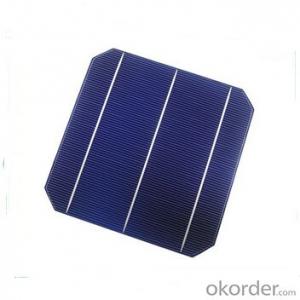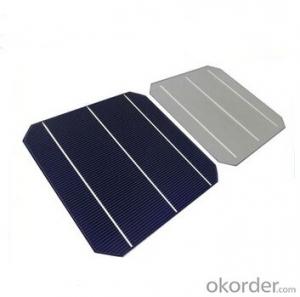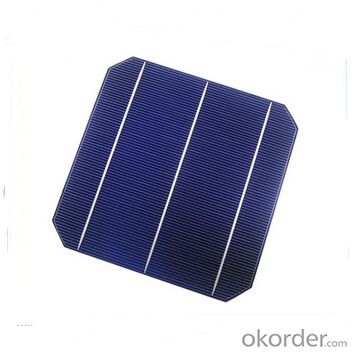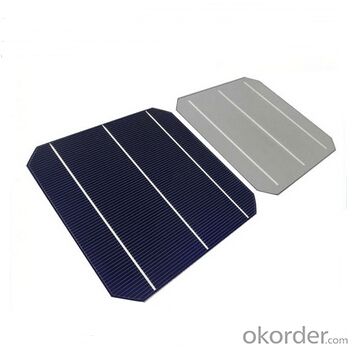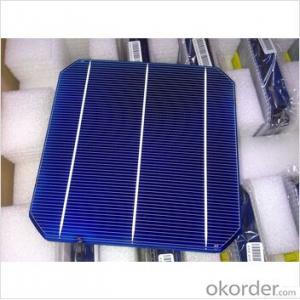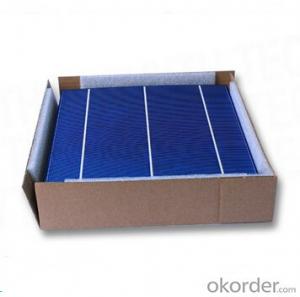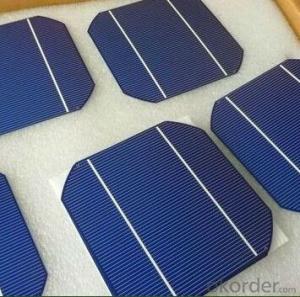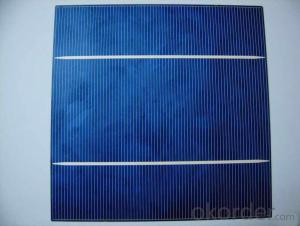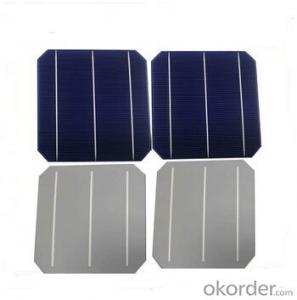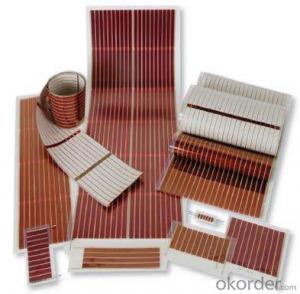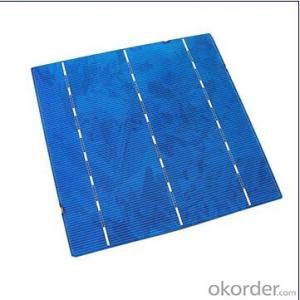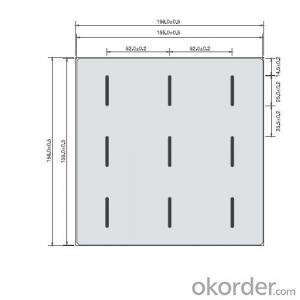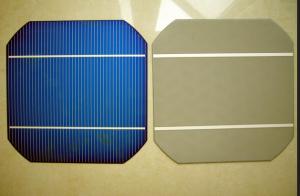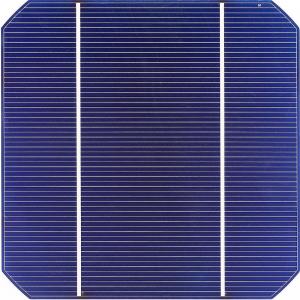American Made High Quality Monocrystalline Solar Cells 15.00-18.50
- Loading Port:
- Shanghai
- Payment Terms:
- TT OR LC
- Min Order Qty:
- 1000 pc
- Supply Capability:
- 1000000 pc/month
OKorder Service Pledge
OKorder Financial Service
You Might Also Like
Solar Cells:
Solar cells is made by solar wafer, it has three categories of solar cell right now, monocrystalline polycrystalline and thin film,These cells are entirely based around the concept PN junction, which is the critical part of solar module, it is the part that can convert the light energy into electricity, the thickness is from 180um to 200um, with even busbars to conduct electricity, textured cell can decrease diffuse reflection; they are often electrically connected and encapsulated as a module. Photovoltaic modules often have a sheet of glass on the front (sun up) side, allowing light to pass while protecting semiconductor wafers from abrasion and impact due to wind-driven debris, rain, hail, etc. Solar cells are also usually connected in series in modules, creating an additive voltage. Connecting cells in parallel will yield a higher current;With high quality and stable quality. Our Cells can greatly improve the performance of Solar Modules.
Up to 20.0% efficiency, one of the highest performing mono crystalline cells on the market
Three bus bars boosts current collection over the entire cell area, leading to higher fill factors and MORE POWER
Blue anti-reflecting coating allows more sunlight be captured and converted to electricity
Finer, closer fingers improves charge collections for improved energy yield
Lower light-induced degradation leads to greater power output over the entire module lifetime
All solar cells are tightly classified to optimize output of module
Maximum yield and longevity due to hotspot prevention
Premium appearance results in a highly uniform and aesthetically appealing module
Solar Cells Advantage:
• High efficiency and stable performance in photovoltaic conversion.
• Advanced diffusion technique ensuring the homogeneity of energy conversion efficiency of the cell.
• Advanced PECVD film forming, providing a dark blue silicon nitride anti-reflection film of homogenous color and attractive appearance.
• High quality metal paste for back surface and electrode, ensuring good conductivity, high pulling strength and ease of soldering.
• High precision patterning using screen printing, ensuring accurate busbar location for ease with automatic soldering a laser cutting.
Specifications:
Efficiency(%) | Pmax(W) | Vmp(V) | Imp(A) | Voc(V) | Isc(A) |
18.50 | 4.398 | 0.525 | 8.337 | 0.625 | 9.142 |
18.25 | 4.338 | 0.523 | 8.294 | 0.623 | 9.080 |
18.00 | 4.279 | 0.520 | 8.229 | 0.621 | 9.011 |
17.75 | 4.222 | 0.516 | 8.178 | 0.619 | 8.942 |
17.50 | 4.163 | 0.512 | 8.131 | 0.617 | 8.869 |
17.25 | 4.104 | 0.508 | 8.077 | 0.615 | 8.803 |
17.00 | 4.044 | 0.503 | 8.038 | 0.613 | 8.763 |
16.75 | 3.990 | 0.501 | 7.973 | 0.612 | 8.698 |
16.50 | 3.935 | 0.499 | 7.889 | 0.611 | 8.620 |
16.25 | 3.877 | 0.497 | 7.800 | 0.611 | 8.545 |
16.00 | 3.818 | 0.494 | 7.725 | 0.610 | 8.494 |
15.75 | 3.760 | 0.492 | 7.647 | 0.610 | 8.444 |
15.50 | 3.700 | 0.489 | 7.565 | 0.610 | 8.398 |
15.25 | 3.641 | 0.486 | 7.490 | 0.609 | 8.362 |
15.00 | 3.581 | 0.483 | 7.419 | 0.608 | 8.338 |
Packaging & Delivery of Solar Cells
Carton Box Package and Deliver by air. It should be noticed that it should be avoid of water, sunshine and moist.
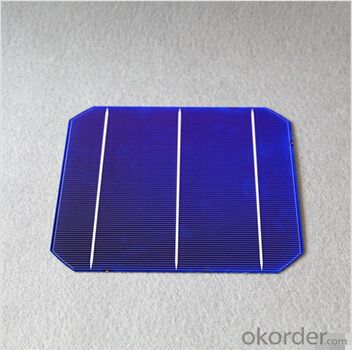
FAQ
We have organized several common questions for our clients,may help you sincerely:
①What price for each watt?
It depends on the efficiency of the solar cell, quantity, delivery date and payment terms.
②How long can we receive the product after purchase?
In the purchase of product within three working days, We will arrange the factory delivery as soon as possible. The pecific time of receiving is related to the state and position of customers.Commonly 7 to 10 working days can be served.
③Can you provide the peripheral products of the solar panels, such as the battery, controller, and inverter? If so, can you tell me how do they match each other?
Yes, we can, we have two companies for solar region, one is CNBM International, the other is CNBM engineering Co.
We can provide you not only the solar module but also the off grid solar system, we can also provide you service with on grid plant.
④What is your warranty of solar cell?
Our product can promise lower than 0.3% open box crack, we support claim after opening the box if it has crackm color difference or sth, the buyer should give pictures immediately, we can not accept the claim after the solar cell has assembled to solar panel.
• Timeliness of delivery
• ⑤How do you pack your products?
We have rich experience on how to pack the solar cell to make sure the safety on shipment, we could use wooden box or pallet as buyer's preference.
- Q: Can solar cells be used in recreational vehicles?
- Yes, solar cells can be used in recreational vehicles. They are a popular and effective solution for powering various systems in RVs including lighting, appliances, and electronics. Solar panels can be mounted on the roof of an RV to harness sunlight and convert it into electricity, providing a reliable and sustainable source of power while on the road or during camping trips. Additionally, solar cells offer the advantage of being environmentally friendly and reducing reliance on traditional energy sources.
- Q: Are there any subsidies or incentives for installing solar cells?
- Yes, there are subsidies and incentives available for installing solar cells. Many governments and local authorities offer financial incentives such as tax credits, grants, and rebates to encourage the adoption of solar energy. Additionally, some utility companies provide feed-in tariffs or net metering programs, which allow solar system owners to sell excess electricity back to the grid or receive credits on their energy bills. These subsidies and incentives aim to make solar installations more affordable and promote the transition to clean and renewable energy sources.
- Q: How do solar cells generate electricity at night?
- Solar cells do not generate electricity at night as they rely on sunlight to convert photons into electrical energy.
- Q: Can solar cells be used in telecommunications infrastructure?
- Yes, solar cells can be used in telecommunications infrastructure. They can provide a reliable and sustainable power source for various telecom equipment such as mobile phone towers, repeaters, and base stations. Solar cells are particularly suitable for remote or off-grid areas where access to conventional power sources is limited. Additionally, their installation can reduce operational costs and environmental impact, making them an increasingly popular choice in the telecommunications industry.
- Q: Can solar cells be used in space stations?
- Yes, solar cells can be used in space stations. In fact, they are commonly used to provide power to space stations by converting sunlight into electricity.
- Q: What is the internal structure of solar panels
- 3) The main role of the battery is the power generation, power generation main market is the mainstream of crystalline silicon solar cells, thin film solar cells, both of their advantages and disadvantages.
- Q: What is the impact of bird droppings on solar cell efficiency?
- Bird droppings can significantly reduce the efficiency of solar cells. The droppings create a layer of dirt and debris on the surface of the cells, blocking sunlight from reaching the photovoltaic materials. This obstruction can result in a decrease in electricity generation and overall performance of the solar panels. Regular cleaning and maintenance are necessary to maintain optimal efficiency and prevent any long-term damage caused by bird droppings.
- Q: How do solar cells handle power fluctuations?
- Solar cells handle power fluctuations through a process called maximum power point tracking (MPPT), which optimizes the output power of the cell. MPPT algorithms continuously monitor the voltage and current of the solar cell and adjust the load resistance to ensure that the cell operates at its maximum power point, even in the presence of fluctuations in solar irradiance or temperature. This allows solar cells to efficiently convert sunlight into electricity and adapt to changing environmental conditions.
- Q: Can solar cells be used in floating solar farms?
- Yes, solar cells can be used in floating solar farms. In fact, floating solar farms have gained popularity as an innovative solution to maximize energy production in areas with limited land availability. These floating platforms are equipped with solar panels, which convert sunlight into electricity, just like traditional solar farms. The buoyant structures allow for the installation of solar panels on water bodies such as lakes, reservoirs, and even oceans, making it an efficient way to harness solar energy while minimizing land use.
- Q: Can solar cells be used for powering electric gates?
- Yes, solar cells can be used for powering electric gates. Solar cells convert sunlight into electricity, which can be used to charge batteries that power the electric gates. This renewable energy source is an environmentally friendly and cost-effective solution for gate automation.
Send your message to us
American Made High Quality Monocrystalline Solar Cells 15.00-18.50
- Loading Port:
- Shanghai
- Payment Terms:
- TT OR LC
- Min Order Qty:
- 1000 pc
- Supply Capability:
- 1000000 pc/month
OKorder Service Pledge
OKorder Financial Service
Similar products
Hot products
Hot Searches
Related keywords
